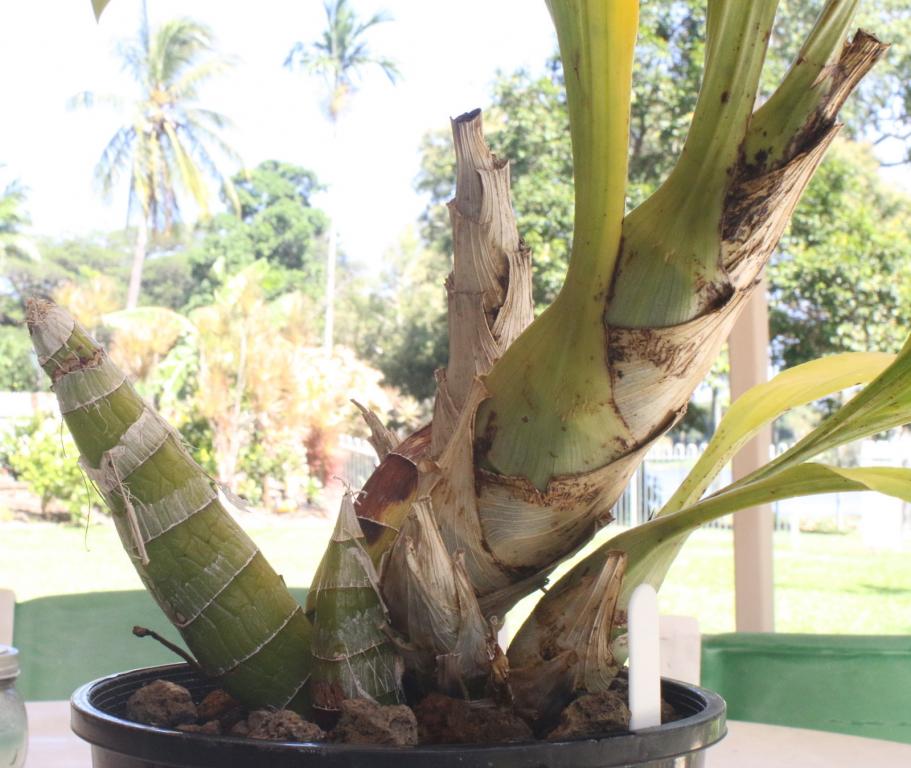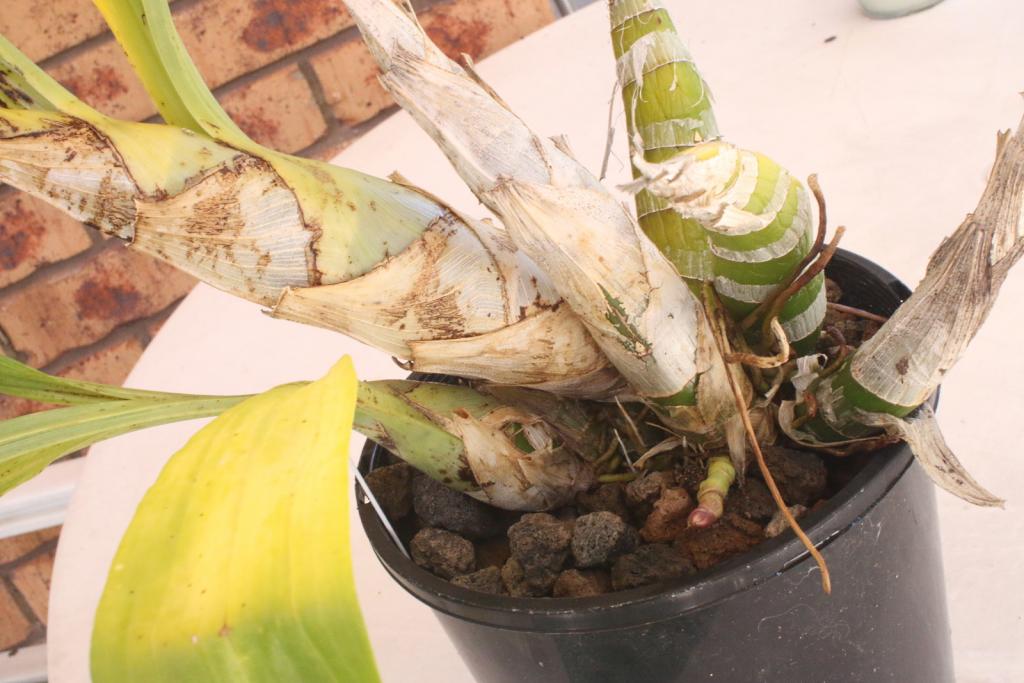


Donate Now
and become
Forum Supporter.

Many perks!
<...more...>


|

04-02-2021, 04:38 AM
|
|
Senior Member
|
|
Join Date: Dec 2018
Location: Australia, North Queensland
Posts: 5,212
|
|
 Fdk. After Dark
Fdk. After Dark
I have a nice pic from around mid December 2019 of an Fdk. After Dark - initially grown in the shade at the time, along with my other catasetum type plants.
The growth for the 2019/2020 season didn't produce any flower spike(s) ------- or at least at first - no flower spike(s) were produced. I didn't mind at all, as I knew that the orchid would eventually produce spikes one of these days or years.
For 2021 - this year - I gave full sun conditions for some of the plants - including this one here that has been growing in scoria for a couple of years - or a bit more than 2 years now.
This season's growth produced no flower spike(s) just yet. However --- the old bulb from last season has kicked into action ----- with a flower spike coming out.
This one is meant to have 'black'-coloured (near-black-coloured) flowers - even though it's not an 'SVO Black Pearl'. So fingers crossed and hopefully it all goes well. But definitely nice to see a spike coming out from last season's bulb.
I've uploaded a couple of pics - before and after shot, showing the label ' D' that shows the same bulb (that is currently producing the flower spike) in the before and after pic.
In the most recent pics (taken today) - the big bulb with the leaves is not the same leafy bulb in the 'before' pic. The leafy bulb in the 'before' pic is the spiking bulb with dried up bits of leaves wrapped around it.

'before' shot - mid December, 2019. Almost beginning of 2020.

'after' shot - 2-Apr 2021



Last edited by SouthPark; 04-04-2021 at 09:35 AM..
|
|
Post Thanks / Like - 3 Likes
|
|
|
|
|

04-02-2021, 04:39 AM
|
|
Senior Member
|
|
Join Date: Dec 2018
Location: Australia, North Queensland
Posts: 5,212
|
|
I forgot to mention - in full sun conditions, I just used a garden hose to water the plant. Just dumped water into the 100% scoria-filled pot with the garden hose connected to a regular water tap - watering it each morning like a regular plant. These orchids are incredibly hardy.
The three larger pics were taken on 2-Apr-2021.
One thing I learned out of this is -------- regarding the question of ----- can old leafless bulbs that have been doing nothing for many months (eg. 12 months or more) develop a flower spike?
The answer is ------ yes ----- they sure can develop a flower spike.
Last edited by SouthPark; 04-04-2021 at 09:55 AM..
|
|
Post Thanks / Like - 1 Likes
|
|
|
|
|

04-06-2021, 07:33 PM
|
|
Senior Member
|
|
Join Date: Dec 2018
Location: Australia, North Queensland
Posts: 5,212
|
|

One additional note about this catasetum hybrid type orchid, and all the other ones in my collection.
For two seasons now - for my warm tropical conditions - I purposely added water to all newly emerging roots from new growths - making sure to not drown any roots.
And the result - no issue at all with roots. No dying roots. No stunted roots. Good bulb size. And flower spikes produced.
I'm going to continue this same treatment for the third growing season as well ------ not because I need to do it. But simply to indicate to others that water on brand new roots (emerging) will NOT absolutely and definitely kill and/or stunt the roots.
There are indeed conditions (eg. warm temperature, and warm roots, and good lighting conditions) where nothing bad will happen to the orchid and roots if water gets on the new 'baby' roots.
However - I do fully support the rule-of-thumb method (of not watering until roots and leaves reach a certain stage of development ) that is expected to work well for all climates ----- and for orchids planted in media that can get water-logged - as orchids are coming out of dormancy.
It is true that - when these orchids are coming out of dormancy - with no leaves, or hardly any leaves, then they're not going to need much or any water.
My main disagreement is with those people that firmly say that water on new roots of catasetum type orchids will certainly kill or stunt the roots. That is actually not true. It actually depends on growing conditions - temperature, root temperature, media, potting method.
Wet and relatively cold, or wet and suffocating (down in the media), or wet and cold and suffocating ------ those conditions can/will kill roots and the orchid.

|
|
Post Thanks / Like - 1 Likes
|
|
|
|
|

04-06-2021, 09:27 PM
|
|
Senior Member
|
|
Join Date: Sep 2019
Zone: 10b
Location: South Florida, East Coast
Posts: 5,835
|
|
Looking good buddy
|
|
Post Thanks / Like - 1 Likes
|
|
|
|
|

04-07-2021, 01:08 AM
|
|
Senior Member
|
|
Join Date: Dec 2018
Location: Australia, North Queensland
Posts: 5,212
|
|
Quote:
Originally Posted by DirtyCoconuts

Looking good buddy
|
Thanks DC!
Just going to quickly add that I started to second guess myself on the expected flower colour! I can't find the email from ebay to double-check whether this one is meant to be black-coloured (flower). Fingers crossed that it is.
Otherwise - also ok haha - will be happy with other colours too. But still - hoping my memory isn't failing me.
Interestingly though, I wasn't expecting to see a spike on the old bulb coming out like that.
I still recall the one you purchased - an absolute beauty ----- and remembering saying that it will teach Fred to give you the wrong one hahaha. He's probably crying now as he can't have the wrong one back hehe.
Last edited by SouthPark; 04-07-2021 at 04:25 AM..
|
|
Post Thanks / Like - 1 Likes
|
|
|
|
|

04-07-2021, 07:39 PM
|
|
Senior Member
|
|
Join Date: Apr 2015
Location: Currently "dry" San Diego
Posts: 1,305
|
|
Quote:
Originally Posted by SouthPark

My main disagreement is with those people that firmly say that water on new roots of catasetum type orchids will certainly kill or stunt the roots. That is actually not true. It actually depends on growing conditions - temperature, root temperature, media, potting method.
|
Do you fertilize the new growths as well? I tend to think people's "no water" suggestion to really mean "no fertilizer but certainly needs adequate humidity". I've found that catts with long rest periods happily take watering, but really dislike being fertilized during dormancy (looking at my bifoliates, nobilior...) . I was wondering if it may be a similar thing. |
|
Post Thanks / Like - 2 Likes
|
|
|
|
|

04-07-2021, 08:00 PM
|
|
Senior Member
|
|
Join Date: Dec 2018
Location: Australia, North Queensland
Posts: 5,212
|
|

Quote:
Originally Posted by Jeff214

Do you fertilize the new growths as well? I tend to think people's "no water" suggestion to really mean "no fertilizer but certainly needs adequate humidity". I've found that catts with long rest periods happily take watering, but really dislike being fertilized during dormancy (looking at my bifoliates, nobilior...) . I was wondering if it may be a similar thing.
|
Hi Jeff! As the orchids are coming out of dormancy --- I don't add any fertiliser. When those videos etc talk about 'no watering', they really do mean no watering ----- as in no water on the new roots.
But I think that even if fertiliser is added ----- it will be important to consider concentration. So if the concentration is such that it settles on parts that causes adverse effects ------ as in drying out a root or something, or salt burn etc ----- then that factor should be considered too. Although ------ when they mean water ----- they really mean just regular watering.
Some growers think that for any condition ---- that water will stunt and/or kill the roots. Which I found is not true for all conditions - such as in the tropical warm conditions over here, and I also take care not to suffocate any existing roots in the pot already.

|
|
Post Thanks / Like - 1 Likes
|
|
|
|
|

04-07-2021, 08:31 PM
|
 |
Super Moderator
|
|
Join Date: Jun 2008
Zone: 10a
Location: Coastal southern California, USA
Posts: 13,945
|
|
Jeff -
The "no water" for Catasetinae really does mean "no water". Everything else at my house that wants a "winter rest" gets less water and no fertilizer, but not none... have killed some Den nobile types in "early career" taking the "dry" part too literally. Catasetinae are a completely different animal. Take a look at the SVO notes from Fred Clarke that I posted in a recent thread in this forum, isurus79 also posted a video from Carlos of SVO in the same thread.
|
|
Post Thanks / Like - 1 Likes
|
|
|
|
|

04-07-2021, 11:25 PM
|
|
Senior Member
|
|
Join Date: Apr 2015
Location: Currently "dry" San Diego
Posts: 1,305
|
|
I'm following SVO recommendations (no water!) since this is my first year growing them. The older p-bulbs are getting wrinkly as the new growths emerge. I have been sprtzing them and placing a jar full of water underneath to increase moisture. I'm not sure how much all of it is helping.
I am certainly curious how SouthPark is growing his catasetums - seem to be doing quite well! I may try wetting the top a bit (like growing catts in moss) next year when I have more or less a baseline on what to expect.
|
|
Post Thanks / Like - 1 Likes
|
|
|
|
|

04-07-2021, 11:47 PM
|
 |
Super Moderator
|
|
Join Date: Jun 2008
Zone: 10a
Location: Coastal southern California, USA
Posts: 13,945
|
|
Remember, SP has both heat and humidity. So what works in a tropical area like North Queensland doesn't necessarily apply to temperate California.
Nice thing about Catasetinae is that they reinvent themselves every year. The oldest pseudobulbs will eventually shrivel, that's normal. If the newest ones show signs of shriveling, a sip might help but be stingy. Remember that the oldest pseudobulbs also likely don't have any live roots - year-old roots (on last year's growth) are still useful but older than that are pretty much done (so aren't going to absorb water for their attached old pseudobulbs, either)
|
|
Post Thanks / Like - 1 Likes
|
|
|
|
|
|
Currently Active Users Viewing This Thread: 1 (0 members and 1 guests)
|
|
|
 Posting Rules
Posting Rules
|
You may not post new threads
You may not post replies
You may not post attachments
You may not edit your posts
HTML code is Off
|
|
|
All times are GMT -4. The time now is 09:24 PM.
|

































 Linear Mode
Linear Mode


